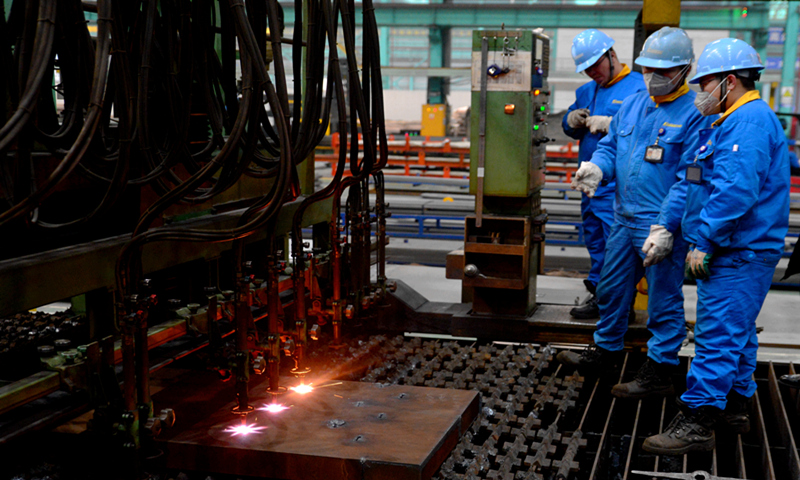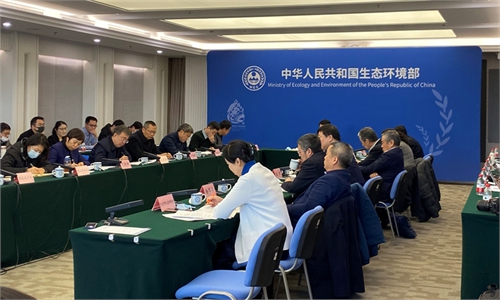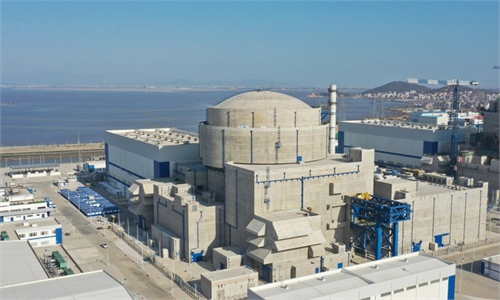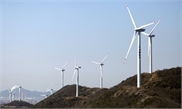
Workers observe the operation of flame cutting equipment at a steel products enterprise in Jingjiang industrial park in Taizhou, East China's Jiangsu province on December 23, 2020. Photo: VCG
China is rolling out proposals related to its goal of hitting peak carbon emissions by 2030, including setting an emission peak target for the steel sector at 2025.
Experts said that achieving the target means that steel costs are likely to rise which might in turn drive up housing and automobile prices. But it would also prompt steelmakers to optimize operations by using more cutting-edge new technologies.
According to a report of the Economic Information Daily, China has generally been clear about its peak carbon emissions goals for the steel industry. The country initially plans to achieve peak carbon emissions in 2025 for the steel sector, five years ahead of the general carbon emissions peak target. By 2030, the volume of carbon emissions in the steel industry is expected to decrease by 30 percent compared with the sector's emission peak.
Wang Guoqing, research director at the Beijing Lange Steel Information Research Center, told the Global Times on Tuesday that controlling total steel output - the most direct way to achieve peak carbon emissions and carbon neutrality - will affect the steel industry in the short term.
"However, this will in turn encourage steelmakers to optimize their production processes by adopting short production flows and boosting the application of new technologies, such as deoxidization with hydrogen to reduce carbon emissions," she said.
Guo Haifei, deputy director of the Green Innovation Center of the Investment Consulting Special Committee under the Investment Association of China, said that it will be hard for Chinese steelmakers to achieve the current peak carbon emissions target by 2025 - but not impossible.
"To achieve the objective, Chinese steel companies have to shift their production methods and replace hard coke with electricity. This would push the cost of steelmaking higher and reduce profit margin, and some steelmakers might reduce production as a result," he told the Global Times.
He also noted that the steel sector's upstream and downstream enterprises will be affected. For example, the coke industry is expected to shrink, while the electricity industry will increase investment in clean sources such as wind turbines.
"Higher steelmaking costs would also increase the costs of raw materials for downstream industries like real estate and infrastructure, which will eventually lead to higher prices for housing. Vehicles will also likely be affected," Guo noted.
The steel industry is a sector that produces the most carbon emissions in China, accounting for about 15 percent of the national total, according to data from the research center. Thus, it's crucial for steelmakers to pursue green and low-carbon development during the 14th Five-Year Plan period (2021-25).
Hebei Province-based HBIS Group, one of the biggest steelmakers globally, released its green development action plan in mid-March, vowing to reach carbon emissions peak in 2022 and cut carbon emissions from the peak by 10 percent in 2025 and 30 percent in 2030. It aims to achieve carbon neutrality in 2050.
The company also plans to build the world's first hydrogen metallurgy demonstration facility with a capacity of 1.2 million tons a year, which it's estimated will cut carbon emissions by 40-60 percent compared with the traditional process.
Apart from steel companies, many Chinese industry giants have also rolled out carbon emissions reduction plans. The China National Petroleum Corp, for instance, has set a target to achieve peak carbon emissions by around 2025, while China Petrochemical Corp said that it planned to achieve carbon neutrality 10 years head of the national objective.




